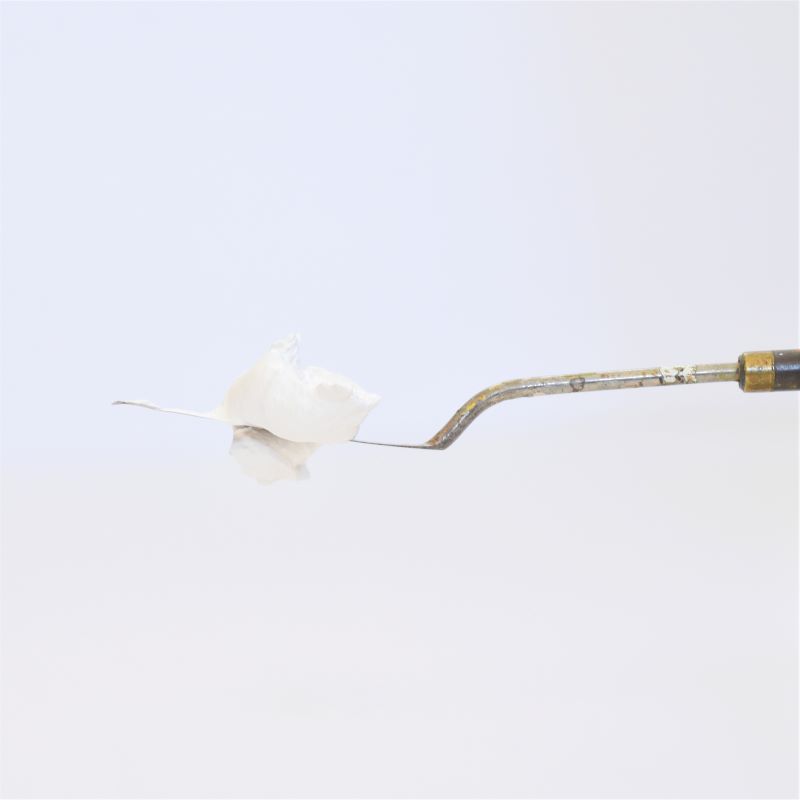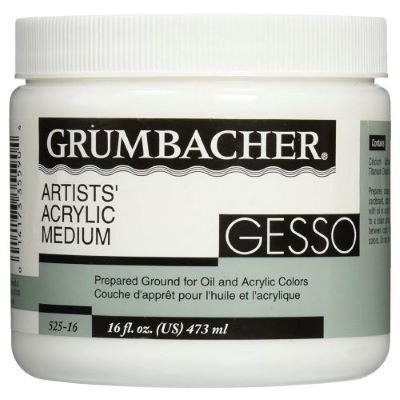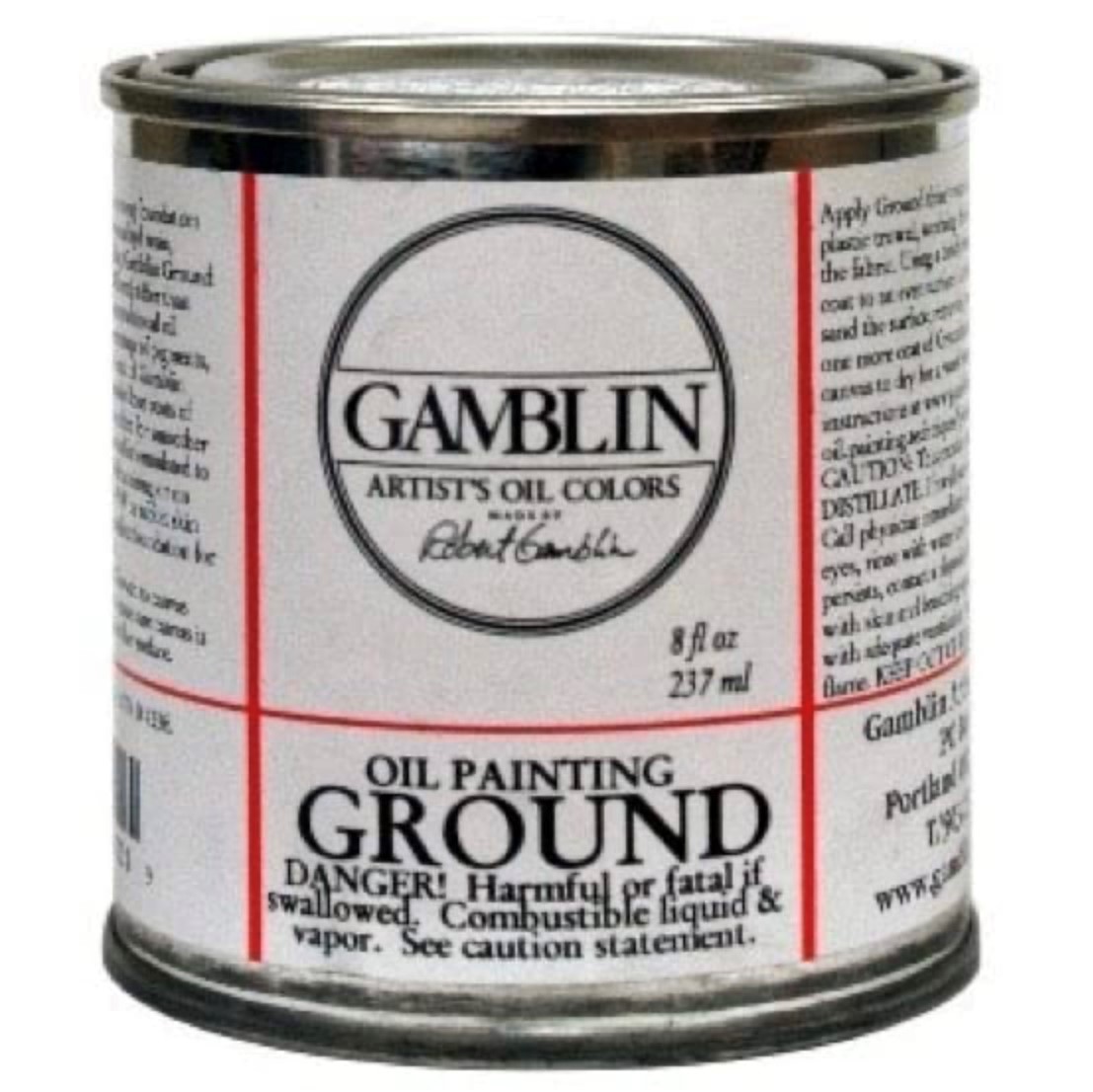Gesso is the foundation of a painting. It is a paint like substance that is brushed on a canvas or substrate to prepare it for painting. It’s purpose is to protect the canvas from paint and provide a smooth painting surface. The brushed on gesso also has a bit of “tooth” which makes paint adhere to it.
Canvas for painting comes either primed or unprimed (bare canvas). You will want to paint on primed canvas. If you have unprimed canvas you will need to prime it with a layer to protect the canvas from the paint you will apply. If you have primed canvas from the store, you don’t need to prime it, you can go straight to painting!
The most common substance used to prime a canvas is gesso. Using a brush, paint on an even layer of gesso over your canvas.
Note that canvas is available already primed. You can buy canvas pre-primed with acrylic or oil gesso and in fact most stretched canvas available online or in stores is already primed. I buy Frederix cotton canvas pre-primed with acrylic gesso.
As an Amazon Associate, I may earn a small commission at no cost to you if you purchase a product I linked to. This helps me with the cost of running this website. Thank you!
A word about terminology
You’ll see the word “gesso” interchanged with “primer” or “ground”. They all mean the same thing with respect to gesso for painting purposes.
what’s the difference between primed and unprimed canvas?
How do you know if you have primed or unprimed canvas? Primed canvas will have a smooth feel. If you drop a little water on the canvas surface, it will bead up and the primer will prevent it from soaking into the canvas. On the other hand if you have an unprimed canvas this means it’s raw canvas. You will be able to see the weave of the canvas and if you drop a little water on the canvas surface, it will soak into the canvas.
Why paint on primed canvas?
1. Primer protects the cotton or linen canvas from the corrosive properties of oil paint and from the rotting effect of the binder in oil paint (linseed oil) as it oxidizes.
2. Whether you use oil or acrylic, the layer of primer is less absorbant than a bare canvas so it’s an easier surface to paint on. Your brush will flow better over a smooth primed surface.
3. Oil paint may sink into bare canvas as it dries and leave dull or “dead” patches on the surface of your painting.
4. If you wish you can brush on the primer leaving brush marks and lumps of primer to make a “rougher” surface for painting, this is one way to get a looser look or more texture with your paint strokes.
5. You can also sand the surface between applications for a very smooth surface.
You can also prime other surfaces to paint on

Besides priming canvas with gesso, you should prime wood panels or masonite panels before you paint on them. Otherwise your paint will soak into the raw wood or perhaps slide right off a smooth masonite panel. Above is an example of paintings of birds I did on cradled birch wood panels. I used acrylic primer and then painted the background and birds in oil paint.
what kind of gesso should I use for my painting?
Once you’ve determined that your canvas is unprimed and you want to prime it, what kind of gesso should you use?
Acrylic Gesso – As an oil painter I use acrylic gesso and paint in oil over the gesso. It’s readily available and easy to work with and clean up. Acrylic gesso takes about 10 minutes to dry and after a quick sanding, I paint right on top of that. It should be noted that if you are painting in acrylic, you do not technically need to apply a coat of primer but it will be easier to create your painting if you have an even smooth surface that doesn’t absorb paint as you create.
Oil Painting Ground – Gamblin makes a great non-toxic oil painting ground. They recommend you wait two weeks before painting over this layer so it’s completely dry. From Gamblin’s website: “Gamblin Oil Painting Ground makes a strong, bright, non-absorbent foundation for oil paintings. Gamblin Ground is formulated from alkyd resin, titanium dioxide, and calcium carbonate – titanium dioxide gives opacity, while calcium carbonate gives tooth for strong adhesion.”
Traditional lead oil grounds – Traditinal oil grounds were made with lead white paint because lead paint is stronger and more flexible than Titanium white. Lead white paint is toxic but still used with care for it’s permanancy and luminosity.
Old fashioned primer that I mixed myself – I was able to purchase the proper ingredients and then made my own primer (gesso) the “old fashioned way” and let me tell you, it was a smelly mess. It involves pellets of rabbit-skin glue, chalk, pigmens and boiling of these ingredients. I did it because this is how the Old Master’s did it. I strive to use the best materials and processes and thought this might be worth doing. But for me it wasn’t, I prefer to use the excellent products that are readily available and spend my time painting.
What you need

Below are my choices for acrylic gesso and oil gesso (non-toxic). Remember, you can use acrylic gesso if you are going to paint in oil (that’s what I do). I’ve also included a basic brush to spread the gesso. Any kind of household brush will work. The better the brush, the fewer bristles will fall out and have to be picked out of the gesso.
Alternatives to Gesso Primer
You can use other substances to prime a canvas if for some reason you can’t get your hands on proper gesso. You can also use:
acrylic medium – this will seal the canvas though generally will be a clear substance
clear gesso – you can buy this if you don’t want the white gesso. I’ve used it over bare wood so the wood grain shows
rabbit skin glue – we talked about that in a section above
What IS gesso made of?

Acrylic gesso is made of an acrylic polymer medium (this is the glue or binder, notice no rabbits involved), chalk and a pigment (Titanium white) and chemicals that allow the gesso layer to be flexible enough that it won’t crack.
how to apply gesso for painting?
Gesso is applied on a surface (canvas, wood or masonite) with a brush or palette knife. For acrylic gesso two coats are recommended. Acrylic primer dries in about 10 minutes. For oil primer three to four coats are recommended. Make sure each layer is dry before applying the next layer, each layer can take 2 days to a week, depending on temperature and humidity.

It’s as easy to apply gesso or primer to a surface as it is to apply paint. You’ll need a bowl or cup to put your primer in. Primer can be thick so I spoon some into a bowl and add a little water if necessary and then mix well. The gesso should be a thick creamy consistency and you should be able to spread it on with a brush without it being runny. Other than that all you need is a brush to apply the primer. Or perhaps a palette knife or spreader. I use a brush 2″ to 4″ wide, depending on the size of my canvas.
If you want a very smooth surface you can sand the dried gesso between applying layers. Sometimes I brush on the primer and let the brush marks show to get a rougher painting surface. This helps add texture to my brush strokes.
cotton or linen canvas?
Everything discussed here about gesso applies to cotton or linen canvas. Whether you use cotton or linen canvas is a personal descision. Linen canvas typically has a smoother weave and is used for paintings with finer detail that might get lost in the larger weave of cotton canvas. For example, portaits are typically painted on linen canvas.
You will see “Belgian linen” often because linen is produced in Western Europe and especially Belgium. Linan canvas is more durable and longer lasting than cotton canvas because linen canvas is made of flax, a stronger natural material than cotton. Linen canvas is more expensive to make because flax is harvested by hand, cotton is harvested by machines.
I paint on both. I also paint on wood panels that I gesso as mentioned above. It’s a great idea to experiment with different materials to see what suits you best.
Summary
I hope this post has helped you understand how gesso is used for painting and the important role gesso plays in the creation of a painting. Please let me know if you have any questions in the comments. Happy Painting! Joan




